ANSMET team • Jan 18, 2009
The Antarctic search for meteorites: tantalizingly close to the 500-meteorite mark
January 14-18, 2009

Meteorite number 19438
This meteorite (field number 19438) broke while on Earth along a black, planar surface (upper right), quite likely a shock vein.ANSMET
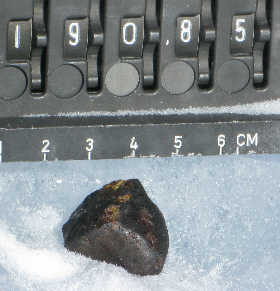
Meteorite number 19085
This meteorite (field number 19085) is fully fusion-crusted and angular (tetrahedral) in shape.ANSMET
When worldlets collide
January 14, 2009
Meteorites come from the asteroid belt, but the entire asteroid does not hit us. So how do meteorites arrive at the Earth? The answer is, asteroids are playing bumper-cars. The old saying is that you cannot make an omelet without breaking eggs. Well, you cannot make meteorites without smashing asteroids. We are seeing evidence of this process in some of the meteorites we have been collecting.
Many of the meteorites we have been collecting are of the broad category of ordinary chondrite. This is not surprising because ordinary chondrites make up roughly two thirds of all meteorites that have fallen in the last two hundred years or so. Many of the stones we collect are nearly completely fusion-crusted. (The fusion crust is a glassy coating on meteorites that forms during passage of the meteorite through the atmosphere.) For many of the ordinary chondrites we find, the fusion crust is in about the same state of preservation, or put another way, they appear similarly "fresh." This suggests, but does not prove, that many of the meteorites may have fallen at about the same time.
Another similarity began to show up as we began to collect more and more. Some of the meteorites have part of their fusion crust broken off, affording a glimpse of the interior. We began noticing a textural feature shared by some. A few had semi-linear black streaks cutting across the interior. Several others were broken while on Earth along very flat, planar surfaces coated with black material. This black material was clearly distinct in luster from the fusion crust preserved on external surfaces. Finally, some of the meteorites that were fully fusion-crusted were quite angular, with flat faces. Some were very nearly tetrahedral in shape - three sided pyramids!
A common feature seen in laboratory studies of meteorites is "shock veins." These are narrow, planar or curvilinear bands were the minerals have been broken and melted by the energy of an impact on their parent asteroid. In ordinary chondrites, these shock veins are black because they contain finely disseminated tiny particles of metal and iron sulfide. The black streaks we see in the interiors of some samples, and the black planar faces on others, are quite likely such shock veins.
Putting it all together, we have the following working hypothesis: Many (but not all!) of the ordinary chondrites we have been collecting are from the same meteoroid that entered the atmosphere. This bolide broke up high in the atmosphere into a shower of meteorites along zones of weakness in the stone. In some cases, the zones of weakness were shock veins, producing the highly angular stones that are fully fusion-crusted.
The meteoroid itself was the product of an impact on its parent asteroid, but it is too soon to tell if the shock veins were produced by this impact. In fact, the odds are against it. The surfaces of asteroids have suffered numerous impacts during the age of the solar system. The shock veins could have been formed at any time during the last four and a half billion years. I will wager my first-born son that when someone begins to study these meteorites, they will conclude that many of them are highly shocked meteorites, and that they are parts of a single fall event.
This is one of the reasons I like working with ANSMET. By seeing many, many meteorites as they are collected in the field, one begins to see patterns that can lead to a working model of the history of the rocks.
Today we got out and searched in the area at the base of Mount Ward, our nemesis. As usual, the winds there were stronger than at camp, forcing us to call it a day by mid afternoon. Even so, we bagged 32 meteorites, bringing our season total to 436.
100 years ago this date: Shackleton and his men marched 10 hours with the wind at their backs and a temperature of -18 F. They are on short rations and thus hungry, yet made 24 miles. They have six days of rations left, and have 120 miles to go to the next depot. You can tell by the brevity of their daily entries now that the disappointment of not making the Pole weighs on them.
Cheers,
LYAN
duck

Katabatic wind blowing snow across the region obscures the nunatak to the east of camp.
ANSMETMother Nature, a harsh mistress indeed
January 15, 2009
Today we were defeated by Mother Nature, yet again. Although we love her, she can be a harsh mistress.
During the night I could hear the wind wailing through the tent ropes, and the blowing snow hissing against the sides of the tent. In the morning, the winds were still up, and the temperature was down, way down. All the way to -23 C (-10 F). John estimated the wind speed at about 40 kph (25 mph). This is the way it was when John and I first arrived at Davis-Ward to groom the skiway. Combined with the low temperature, these winds give us a wind chill of roughly -50 C (-60 F). I’d call that rather nippy, wouldn‘t you?
Snow was blowing through camp, drifting behind any obstacle in its path. Twice I had to shovel snow from around the tent “door” in order to make it easier to get in and out.
From camp we could see plumes of snow blowing off our nemesis, Mount Ward, the evil mountain. Blowing snow was partially obscuring the nunatak to the east. Had John suggested we go out and collect meteorites, there would have been a general insurrection. But Ma and Pa Schutt did not raise such a foolish child. John decided the best place for him today was in the tent, in his sleeping bag, right next to the propane stove, which was running at full blast.
We have only about a week left here. If we get even a couple more good hunting days we can break the 500 meteorite barrier. But this will depend on our getting back in the good graces of Mother Nature. Unfortunately, we have no goats to sacrifice, so the issue is in doubt.
ANSMET haiku:
Katabatic wind
Blowing from the southern land
You freeze my butt off!
100 years ago this date: Shackleton and his mates continue plodding northward. They started the day in a blizzard with a temperature of -23 F. They made 20 miles, but they lost the sledgemeter. They can no long measure distances, so they do not know how far they are from their next depot. Thus they do not know when to start casting right and left of their track to find it.
Cheers,
LYAN
duck
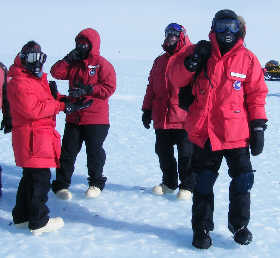
Different styles of Antarctic dress.
Deon, far right, exposes nothing to the environment.ANSMET
Lions and tigers and bears, oh my!
January 16, 2009
Deon here, blogging from another tent day...
Out here in an extreme environment we have to contend with deceptively veiled danger all the time. Reading about the hardships that the Shackleton and Scott expeditions faced (including death), reminds us that if it weren't for modern gear and plenty of resources in camp, we wouldn't last very long. There are no polar bears, no leopard seals in our vicinity, no orcas crashing through the ice to devour us, and despite what the X-Files will have you believe, no savage aliens hiding in buried spaceships. The dangers we face are lifeless (unless you count a psychotic tent mate), and involve hypothermia and frostbite from the cold, altitude sickness, falls on the ice, and falling into crevasses. Hang on... writing about all this dangerous stuff has made me hungry now, so excuse me while I go fry up some bacon, apples, and hashbrowns for a snack...
Mmmm that was good, but I think we should add burnt hashbrown smoke as an additional hazard. Our pots are a little temperamental!
Everyone has their own preferences for what gear they wear, but generally speaking to combat the cold and the wind, we layer our clothes, starting with a base layer of thermal underwear, socks, and glove liners. Layers trap air that insulates the body heat, and the base layer performs a wicking function that draws sweat away from the body. This way, it doesn't freeze against the skin. The early explorers did not have good wicking technology, and often the freezing sweat cost them dearly! I personally wear a wicking sock layer as well, with a thicker wool sock over it to keep my feet dry and warm. For those needing "extra" base layer material, there are always the x-rated possum fur liners sold at Scott base!
Over the base layer we wear polar fleece as an insulating layer followed by a windproof shell. Depending on individual's metabolism and blood circulation, some brave the cold with a thin shell we affectionately call "little red", while others wear a thick synthetic down parka we call "big red". It's amazing how well Big Red keeps the wind at bay, although it makes you feel and walk like the marshmallow man from the Ghostbusters movie! In Joe's case, the Michelin tire man. Our shell layer for the pants consists of a windproof overall that covers the chest. This too, blocks the wind remarkably well. Our boots consist of either a pair of "bunny boots" (usually white but I was fortunate to get a stylish black pair) that has a barrier capability to prevent sweat evaporation, or a pair of boots that does not have this capability. The evaporation of sweat cools the feet, so if you have sweaty feet and no bunny boot, you may end up with very cold feet. On the flipside you end up with wet feet if the sweat cannot escape. Fortunately I have neither problem!
Unlike Dorothy from Oz, we do not have a smooth, yellow brick road to follow. The ice is irregular and often rippled with deep troughs as a result of wind action, which makes it a precarious surface to walk on. Add to that the extra complication of slippery ice - which becomes even more slippery when the sun starts melting it on a warmer day - and you end up with a perfect recipe for falling on your bum. Several of us have had the unfortunate experience of finding out what that feels like, and I am personally convinced that the ice is harder than rock (a strange feeling indeed!). Fortunately we wear crampons or stabilizers on our boots to prevent many slips. In my case, the left side does not fit well and keeps falling off (despite some creative fix up attempts by Jani), and I've had a minor wrist injury that's ironically necessitated ICING my hand!
Over the glove liners come one or two layers of gloves or mittens, meant to be insulating and windproof. It took me two-and-a-half weeks to finally find a combination of gloves that kept my fingers from loosing feeling after only a few hours outside. During this process I tried combinations using seven different pairs of gloves! Extremities like our fingers are most prone to damage from the wind and cold. Since we work with our hands, we often have to expose them to the -40F wind chill so that we may collect the meteorites effectively. Needless to say, numb fingers are often the reason for stopping work. Even through all the gloves, you may end up using chemical hand warmers all day long. Frostbite is a real danger for the fingers, and many early explorers have lost fingers, toes, ears, and parts of their face to frostbite. Both Joe and I have thumbs that's split deeply on the end due to exposure. To heal it, Joe uses superglue and I opt for butterfly suture strips. Considering the frostbite that Shakleton's men endured, we have no reason to complain!
Other parts of the body that are highly vulnerable to the elements, are the eyes and face. Due to high reflectance of solar radiation by the snow and ice, we have to make sure we wear sunglasses or goggles that filter this out. Needless to say sun block is high on the list of weatherproofing on the face. The ozone "hole" above Antarctica is also responsible for letting more harmful radiation reach the surface - perhaps a taste of what is in store for other parts of our planet which we so neglect! Some of us wear sunglasses and others prefer goggles. I prefer the goggles for their ability to provide more extensive wind protection over the eyes. Everyone also wears a balaclava and /or facemasks combined with a neck gaiter to provide the face and head with insulation and wind protection. Amy and I tend to have the most extensive face protection with a facemask attached to our goggles, but ironically, only the two of us have suffered frostnip on the face. Frostnip is an early (but less severe and nonpermanent) form of frostbite caused by exposure of skin to very cold wind. This means that we have patches of frozen, dead, black skin on the face. We have been told not to worry, since it will eventually fall off and leave a hole. We hope John was kidding about the "hole-in-the-face" part! But, once again we were outdone by Shackleton's men, since the soles of their feet were peeling off from exposure and hard walking after their boot insulation started to fail...They were using a certain type of grass for insulation!
Lastly, we severely lack the experience that the early explorers had with falling into crevasses. They had a LOT of experience! In fact , it seems they hardly thought anything of it after the first few times of dangling down a bottomless pit, dangling only by rope tied to a colleague or a sled! I doubt we would have the same reaction if any of us fell in. On the blue ice we work on, there are many crevasses that are a few inches wide. If there are no snow on the ice, they stand out nicely, as white snow-filled lineations. Danger from them extends to being unlucky enough to step through the snow that fills it and twisting an ankle. Then there are snow-filled ones on the ice that are wide enough to swallow your snowmobile if you are brave or foolish enough to venture onto them. But they are usually easy to spot and avoid. The really dangerous ones are the ones that lie beneath extensive snow covering, where you cannot tell them apart from the surroundings unless you look for finely hidden tell tale signs. They usually occur in areas we cross between adjacent blue ice fields, and here we rely on John's keen mountaineering eye to safely guide us to safety. Many explorers have died in crevasses! Unfortunately we are not aware of the incidents that Amundson's men faced on his expedition to be the first to reach the South Pole, and it would be interesting to know if they had a safer journey than their British counterparts...
With that I leave you for another cup of hot chocolate. If you own a winged animal, please make it flap its wings so that we may have fairer weather for hunting meteorites tomorrow!
100 years ago this date: Shacklton and his weary mates continued to make progress northward. With a blizzard blowing at their backs, they traveled 18 and a half miles. Shackleton suffers from "burst" heels, a result of frostbite, so every step for him was painful.

ANSMET cryptogram of the day.
Can you solve it?ANSMET
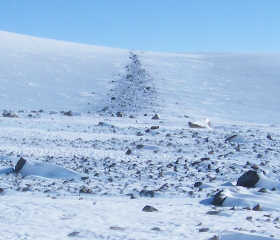
The moraine at the base of Mount Ward that yielded most of the day's haul of meteorites.
ANSMETStir-crazy in Antarctica
January 17, 2009
We started the day in the usual fashion. STUCK IN OUR %@#& TENTS! The winds were still up when I awoke, bright and early, at 10:15. The temperature was -22 C (-8 F). As I mentioned in an earlier blog, one of the things I do to idle away the hours of Mother-Nature-enforced imprisonment is solve cryptograms. Today I created one. See if you can solve it!
But wait a minute! The wail of the wind! Is it? Could it be? During the late morning, the winds seemed to be moderating just a little bit. Or was it just a delusion? John made a daring call: We would go out at 14:30 and try to do a little work. After he returned from telling the others, I started a count-down. After fifteen minutes absent any sign of an angry mob outside our tent, I decided there was no danger of a coup. This was good. I would hate to see ANSMET run by a junta.
When we gathered at 14:30, John suggested we first do a little "clean-up" work, and then try a little foot searching at the base of Mount Ward, the evil mountain. The "clean-up" work was to put in permanent (we hope) marker flags defining the boundaries of the ice we have searched. It is very clear we will not be able to finish the ice fields around Davis Nunataks-Mount Ward. Therefore, we have to delineate the cleared area so that a future ANSMET team will know where to begin.
The foot searching at the base of Mount Ward was a surprise. Bucking recent trends, the winds there were actually very moderate, not biting as usual. We managed to clear another section of ice, and ventured into a moraine upwind of the ice. We found most of the meteorites today in that moraine. For about an hour and a half 's worth of foot-searching, we did all right: 14 more meteorites bagged and tagged. That brings our season total to 450, with the 500 meteorite barrier tantalizingly within reach. Or just out of reach, depending on your outlook. It's kind of a glass half full, half empty thing.
ANSMET haiku
Another tent day
How to pass the time away
Eat, sleep, eat, sleep, eat.
100 years ago this date: The march northward to safety continued for Shackleton and his team. The temperature was -23 F and they had the wind at their backs. They covered 22 and a half miles, and got to their Christmas camp. Bamboo from the camp will make the sail sturdier and help them on their journey.
Cheers,
LYAN
duck
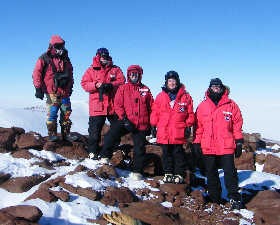
The ANSMET team
The team poses for a victory photo after summiting Mount Ward. From left to right: John, Joe, Jani, Amy, Deon.ANSMET
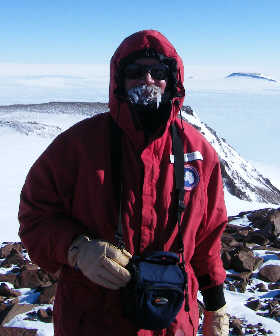
I made it on top too.
Note the impressive display of icicles hanging from my mustache.ANSMET
Mount Ward is our friend
January 18, 2009
You may be surprised by that title, considering how I have been bashing poor old Mount Ward in recent blogs. But we are now on good terms with each other. Let me start from the beginning.
When we got up this morning, it was cold -23 C (-10 F), but there was a only light wind in camp. This would be a good day to go on a meteorite hunt. So off we went at the usual time. We went to the area at the base of Mount Ward. Much to our astonishment, winds there were not much different than in camp! How could that be? We know Mount Ward is our nemesis, plotting evil whenever we show up to work.
We did three ski-doo sweeps that took us all morning. We ended the third sweep right at the foot of Mount Ward. The winds, if anything, had quieted down some. We were either incredibly brave, or extremely foolish, take your pick, but we decided to ascend Mount Ward and have lunch at the summit. A five minute ski-doo ride got us almost to the top. Five minutes of walking up a gentle, but rocky, slope got us to the summit. Guess what? There was no wind at all up there!
The view from the summit was awesome. Displayed before us in 360 degrees was Antarctic scenery and geography. John pointed out some of the nearby (several tens of kilometers away) areas ANSMET has been, and the more well-known geographic features. We also got a good overall view of the ice fields we have been searching. My only regret is that we did not do this sooner. The view from on high really helped put our season's work in geographic perspective.
Sadly, we could not tarry. More meteorites awaited us below. We bid a fond farewell to our new friend and descended to the meteorite fields below. We spent the afternoon foot-searching the moraine and the ice immediately downwind of it. Although The Meteorite Zone has largely petered out, we still bagged a number of stones in that area. The total haul for the day was 39, putting the season total at 489, oh so tantalizingly close to the 500 meteorite barrier. I think we will make it, now that we have made peace with Mount Ward.
100 years ago this date: With the improved sail on the sledge, Shackleton's party made good progress northward. The wind was at their backs, and they were going down hill. They made 26 and a half miles, despite numerous falls into crevasses.
Cheers,
LYAN
duck
Support our core enterprises
Your support powers our mission to explore worlds, find life, and defend Earth. You make all the difference when you make a gift. Give today!
Donate

 Explore Worlds
Explore Worlds Find Life
Find Life Defend Earth
Defend Earth

